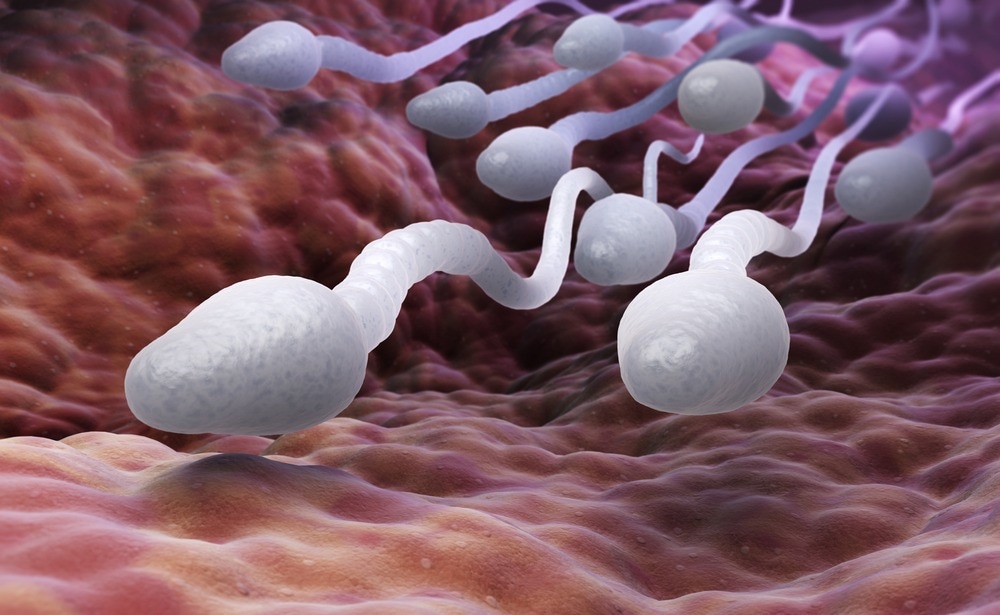In a recent study published in eLife, a group of researchers investigated the Role of Cylicins in Spermiogenesis and Male Fertility in Mice and Humans through Clustered Regularly Interspaced Short Palindromic Repeats (CRISPR)/ CRISPR-associated protein 9 (Cas9) Gene Editing.
 Study: Cylicins are a structural component of the sperm calyx being indispensable for male fertility in mice and human. Image Credit: Tatiana Shepeleva/Shutterstock.com
Study: Cylicins are a structural component of the sperm calyx being indispensable for male fertility in mice and human. Image Credit: Tatiana Shepeleva/Shutterstock.com
Background
Spermiogenesis, transforming round spermatids into sperm, involves complex processes like deoxyribonucleic acid (DNA) condensation and the development of the acrosome and flagellum, largely dependent on a specialized sperm cytoskeleton. The perinuclear theca (PT), a critical component of this cytoskeleton, is composed of several proteins, including Cylicin 1 (Cylc1) and Cylicin 2 (Cylc2).
Further research is needed to fully understand the complex roles of Cylicins in spermiogenesis, given their critical involvement in sperm head architecture and male fertility, as well as their unique protein structure and evolutionary conservation across species.
About the study
In compliance with German animal protection laws and institutional guidelines, experiments on Cylc1- and Cylc2-deficient mice were conducted after receiving necessary approvals. These genetically modified mice were created using CRISPR/Cas9 technology on B6D2F1 zygotes. Two distinct methods were employed: microinjection of Single-guide ribonucleic acids (sgRNAs) and Cas9 messenger RNA (mRNA) for Cylc1, and electroporation of ribonucleoprotein (RNP) complexes for Cylc2. The genotypes of offspring were determined, and gene-edited alleles were isolated through backcrossing with C57Bl/6J mice. These lines were then registered and maintained for further studies.
Genomic DNA extraction followed the HotShot method, and polymerase chain reactions (PCRs) were performed for genotyping. Males of these lines underwent fertility analyses, including mating with C57Bl/6J females and monitoring for pregnancy and litter size. Sperm samples were collected for various analyses, including concentration, viability, motility, and morphology assessments, following established protocols. RNA from testis tissue was extracted for quantitative reverse transcription-PCR (qRT-PCR), focusing on Cylc1 and Cylc2 expression.
Subcellular protein fractions from sperm cells were isolated for western blot analysis. Proteomic studies were conducted using the SP3 approach, followed by Liquid Chromatography-Mass Spectrometry (LC-MS) analysis of the peptides. High-resolution microscopy and transmission electron microscopy (TEM) provided detailed insights into sperm structure and morphology.
Evolutionary rates of Cylicin genes were analyzed to understand their conservation and variation across mammalian species. The study also included a cohort of over 2030 men with reproductive issues, where whole exome sequencing was performed to identify rare genetic variants in CYLC1 and CYLC2. Data from these patients were rigorously analyzed, adhering to American College of Medical Genetics and Genomics - Association for Molecular Pathology (ACMG-AMP) guidelines, to discern any potential links to infertility.
Sanger sequencing validated identified variants, and human sperm samples were examined following world health organization (WHO) guidelines and immunofluorescence staining. Statistical analyses of all experiments were conducted, ensuring rigorous data interpretation and validation.
Study results
The research on Cylicins has revealed several significant findings concerning their role in spermatogenesis and fertility in both mice and humans. Cylicin deficiency was observed to cause acrosome detachment from the nuclear envelope (NE) during the cap phase of acrosome biogenesis. This effect mirrors the loosening of the acroplaxome from the outer nuclear membrane seen in the loss of CCIN, another protein crucial for the Acrosomal Membrane (IAM)- PT- Nuclear Envelope (NE) complex. It is speculated that Cylicins, possibly in conjunction with CCIN, form a 'molecular glue' necessary for acrosome anchoring.
Additionally, Cylicin deficiency in mice led to other notable morphological defects in mature sperm, including excessive elongation of the manchette, its delayed disassembly, and the formation of unusual gaps in the PT at the perinuclear ring level. These defects are thought to stem from malfunctions in intra-manchette transport (IMT), a process crucial for protein transport during spermiogenesis. The results indicate that Cylicins might play a role in maintaining the integrity and contact between the caudal and apical PT regions.
Evolutionary analysis of the Cylc1 and Cylc2 genes across primates and rodents showed that both are under purifying selection, with Cylc1 being under slightly less controlled constraint than Cylc2. This observation led to the hypothesis that Cylc1 loss might be less severe and could be compensated by Cylc2 due to partial redundancy. In male mice, Cylc1 deficiency resulted in subfertility, whereas the loss of both Cylc2 alleles led to infertility, supporting this hypothesis. Furthermore, Cylc2+/- males retained fertility, suggesting that a single functional Cylc2 allele could compensate for the loss of Cylc1, although at least two functional alleles are required for full male fertility.
The study also noted that the evolutionary rate of the C-terminal lysine-rich region of Cylicins is highly variable, fluctuating between conserved and positively selected codon sites. The lysine residues themselves are strongly conserved, indicating that changes in the C-terminal region might confer an adaptive advantage.
In human cases, sperm morphological defects and infertility observed in a patient with variants in both Cylicin genes corroborate the findings in mice. The absence of CYLC1 and impaired CCIN localization in the patient's sperm suggest that PT proteins play similar roles in humans and rodents. However, the study acknowledges the possibility of discrepancies between species and the need for further research to confirm the implications of these variants in human infertility.
Finally, the study mentions a case where the father of a patient inherited the CYLC2 missense variant but did not experience complete infertility, although he reported difficulties in natural conception. This observation suggests a potential effect of pathogenic heterozygous CYLC2 variants on fertility. The research emphasizes the need for further identification and characterization of patients with CYLC1 and CYLC2 variants to draw more definitive conclusions about their impact on spermiogenesis and infertility.